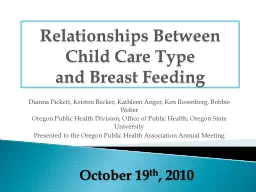

Child Care Type and Breast Feeding Dianna Pickett Kristen Becker Kathleen Anger Ken Rosenberg Bobbie Weber Oregon Public Health Division Office of Public Health Oregon State University Presented to the Oregon Public Health Association Annual Meeting ID: 370864
Download Presentation The PPT/PDF document "Relationships Between" is the property of its rightful owner. Permission is granted to download and print the materials on this web site for personal, non-commercial use only, and to display it on your personal computer provided you do not modify the materials and that you retain all copyright notices contained in the materials. By downloading content from our website, you accept the terms of this agreement.
Slide1
Relationships Between Child Care Typeand Breast Feeding
Dianna Pickett, Kristen Becker, Kathleen Anger, Ken Rosenberg, Bobbie WeberOregon Public Health Division, Office of Public Health; Oregon State UniversityPresented to the Oregon Public Health Association Annual Meeting
October 19
th
, 2010Slide2
2Let’s go back in time to the
OPHA Conference 2009
Monday
October 26
10:45 amSlide3
3Among preschoolers in general, there is a higher proportion of
3-4 year olds in child care centers than 1-2 year olds.Families in poverty with employed mothers and preschoolers use relative care more often than centers care.
CENSUS REPORT ON CHILD CARE (data from 2002, published 2005)
Who’s taking care of the kids
in Oregon?Slide4
1/3 of children in care are in paid
care: 32.9%
2/3
unpaid care…
Think
“unregulated” care:
67.1%
4
Who’s taking care of the kids
in Oregon?
Child Care and Education in Oregon and Its Counties: 2008 Oregon Child Care Research Partnership June 2009Slide5Slide6
Using PRAMS and PRAMS 2 data we looked at breast feeding initiation and duration
related to child care arrangements.How does the breastfeeding
infant fare in
child care?Slide7
Oregon PRAMS :Stratified random sample of live births to Oregon resident womenWomen participate by mail or phone when their infant is 2-3 months oldApproximately 75% weighted response rate in 2004 and 2005
Results are weighted Oregon PRAMS-2Follow-up survey for PRAMS respondents when their child is 2 years oldWomen participate by mail or phoneApproximately 57% response rate for 2004 and 2005 births (weighted back to original PRAMS sample)
Results are weighted
7
Oregon PRAMS: Pregnancy Risk Assessment Monitoring SystemSlide8
What are your childcare arrangements? %
Childcare center15.2%Child’s grandparent14.6%
Childcare in non-relative’s home
13.0%
Other
7.2%
Paid care in your home
6.8%
Other relative
3.5%Babysitter/friend/neighbor
3.4%
Chose more than one response
36.2%
Childcare Arrangement (PRAMS-2)
Do you have regular childcare arrangements for your two-year–old now?
%
YES
51.1%
NO
48.9%Slide9
Who uses which types of child careWe grouped respondents based on
age, race, education, and breastfeeding duration.
LEAST
likely to
have risk factors used
FORMAL
care settings
:
-Childcare center
-Paid in-home care
-Non-relative’s home
MOST
likely to have risk factors used
INFORMAL
care settings:
-Other relatives
-Grandparents
-Babysitter/Friend
Neighbor
-Other
?Slide10
Differences by Child Care Type
Average
age
*
% High school or
less*
%
Non-white
% Not
Married*
% <100%
FPL*
Women using
FORMAL
care
30.93
21.2%
18.5%
18.9
%
11.0%
Women using
INFORMAL
care
27.93
52.6%
24.6%
33.3%
27.4%
ALL PRAMS-2
respondents**
28.68
49.0%
28.3%
27.7%
28.3%
*At birth of index child
**Includes women with multiple types of child care and no regular child care
PRAMS and PRAMS-2, 2004-2005 birthsSlide11
Breastfeeding Rates by Childcare Type
PRAMS and PRAMS-2, 2004-2005 births
*Includes women with multiple types of child care and no regular child careSlide12
Health
C
are Differences by
Child
C
are Type
PRAMS-2, 2004-2005 births
*Includes women with multiple types of child care and no regular child careSlide13
Dental
Care Differences
by Child
C
are
Type
PRAMS-2, 2004-2005 births
*Includes women with multiple types of child care and no regular child careSlide14
We are not claiming that childcare type causes differences in breastfeeding rates. There are differences in the characteristics of women using different types of child care.Women using informal care appear to be more vulnerable than other groups in the areas of:Breastfeeding
Having a regular health care provider for their childDental care for their childSummary of PRAMS FindingsSlide15
Prevention and health promotion for informal child care providers
Offer training on breast feedingConsult on breast feeding-friendly practices.
Promote child health insurance programs
Encourage child health record-keeping and immunization up-dating processes
Share what PRAMS data has revealed with others.
Target
!Slide16
Full report available at:
http://www.clasp.org/admin/site/publications/files/homevisitingkinshipffn.pdfSlide17
Relationships Between Child Care Typeand Breast Feeding
Dianna Pickett , Healthy Child Care Oregon Office of Family Health971-673-0259dianna.l.pickett@state.or.us
Kristen Becker, Research Analyst
Office of Family Health
971-673-0345
kristen.l.becker@state.or.us